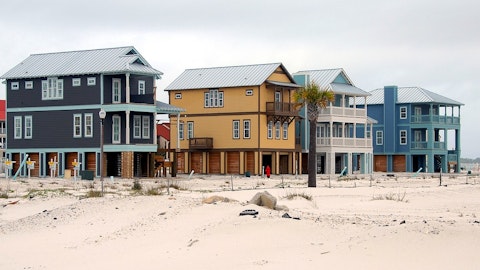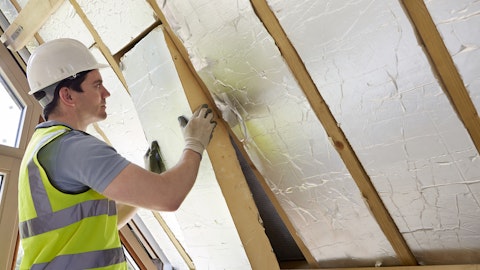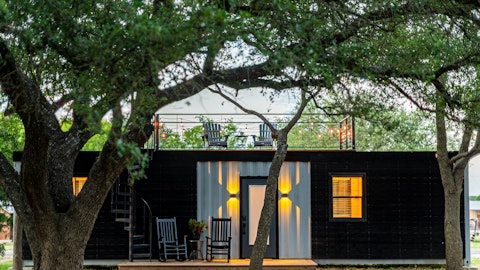Stephen Kim: Excellent. Thanks so much for that. It was very clear. And then taking it a step further, can we talk a little bit more about our capital allocation, again, under this hypothetical scenario, which hopefully doesn’t actually manifest. If we do enter a softer demand patch, you’ve been pretty good with capital allocation in terms of dividends, and buybacks and so forth. Would you likely though, shift even more capital to buybacks as opposed to investing in land, particularly since you have a lot more cash actually than you did last year? And more broadly, with emerging long-only interest in the space, do you feel maybe the time is right to pursue, a more asset-light strategy that might bring your year supply of owned land down to like two years or less, as we think about the longer-term positioning of the company strategy?
Douglas Yearley: Yes. Our next debt maturity, as Marty said, is November of 2025 which is fiscal ’26. We’ve been generating more than $1 billion of free cash flow for the last several years, three or four years. We have dropped our lot count by 15%, still being able with a lot – land we control to grow community count last year, this year, next year and beyond. Our land teams are very good at structuring land deals, to be more capital efficient. We’re doing joint ventures. We’re relying upon land bankers. We’re getting purchase money mortgages from land sellers. We’re buying improved lots just in time. Can we get it down to two years owned, that’s hard to do when you control main in Maine. That’s all I’ll say. We’re moving in the direction of having less owned land, but I’m not going to agree that two years is possible only because our business model, where we buy land is a bit different.
Our land is very special. It’s very unique and not every deal lines up with somebody there to feed you finished lots at the corner main in Maine in Greenwich, Connecticut, Princeton, New Jersey, Irvine, California…
Martin Connor: Radnor, Pennsylvania.
Douglas Yearley: Radnor, Pennsylvania – take it home. But we are moving in that direction, and you will continue to see that effort as we go forward.
Operator: The next question comes from Joe Ahlersmeyer with Deutsche Bank. Please go ahead.
Joe Ahlersmeyer: Hi. Good morning, everybody. Congrats on the results.
Douglas Yearley: Thanks Joe.
Joe Ahlersmeyer: I wanted to dig in on that point you made earlier, about the higher down payments, lower loan to values. If you could maybe just hit on the psychology of this, whether you feel like your buyers are different in this regard. Meaning again, for those three out of four that are taking a mortgage, a 20% down payment, maybe a certain monthly payment, but are we sort of infer – to infer that even with rates at higher levels, there is sort of cash on the buyer’s balance sheet, that they’re using to knowingly pull forward that cash outlay, and just reduce their overall debt service?
Douglas Yearley: Joe, for sure. And to put it – I know I said it, but I’ll remind everybody, long-term, 20% of our clients were all cash. This quarter was 25%. And there’s a good reason for it. I have the money. I’m wealthy, and I don’t love a 7.5% rate. So, I’ll put more of my own money to work and less of the bank’s money to work. Our LTV has gone from 70%, it is for those that do get a mortgage to 68%, same reason. I’m going to put a little bit more down. Our buyers are clearly wealthier. They have equity in their homes. Remember, the resale market is very interesting, but good, solid used homes. Sorry, we like that term as new homebuilders. They sell, and they’re selling quickly, and they’re selling, in many cases, above asking price.
What is sitting on the market is the old tired inventory which actually makes it even better for us, because not only is the resale market really tight. But the quality of what’s sitting on the resale market is lousy. We hope our buyers have some of the better homes that are moving faster. And therefore, they may be getting a bit more equity out of their home than they had thought. So they’re wealthier. They’re getting a bit more equity out of the existing home, and they want to move. I talked about it on the last call, find a house for people besides Marty Connor, our CFO, is not a strict financial decision, it’s a family decision. It’s emotional. It’s moving all of your life. It’s getting the kids in the better school. It’s moving down as an empty nester.
It’s buying the second home. And all of that wins, it trumps the straight financial calculation on the back of a napkin, and where do they go? They may start on a resale market. They can’t find anything. We’re really proud of what we do. We’re really good at what we do. We have groupies. People want and aspire to get into the Toll Brothers house. We sell 10,000 a year, hope to sell 12,000, then 14,000 then 16,000, but in the scheme of the 1 million-plus houses, new homes that are sold in this country in a year. We are a small fraction of it, and there are plenty of buyers still out there, that are in the market even at 7.5%. And we’re benefiting from that, and that’s going to continue as our brand gets better and better.
Joe Ahlersmeyer: Yes, it makes a ton of sense. I’m glad you sort of took it that direction, because I think a lot of times, folks are hearing the word tailwind, and maybe understanding it, at least on the existing home inventory point to mean future headwind, right? And I’m just curious if you see it this way. It sounds like you don’t – I don’t want to put words in your mouth, but maybe if you could just in your answer sort of touch on what you see as the most likely scenario for existing home inventory rising, and whether – or not you think for Toll, this actually would represent sort of a follow-on tailwind. Because it means more of your prospective buyers are shaken loose from those existing homes? Thanks.
Douglas Yearley: Yes. I’m not suggesting that a 7.5% market is good for the industry. It has proven to be good for the new homebuilders, because the wider the spread between mortgage of the existing homeowner, and today’s new rate, the more lock-in effect is occurring. So, the resale market is tighter in a 7.5% rate environment than it was in 6.5%. Because there’s more people that are locking in. But all day long, I will take a 5.25% rate market that frees up more existing homeowners to want to move up into our homes. Of course, I’ll take that. And will there be a bit more competition on the resale market, because it is freeing up, yes. But there will be many more of those of those – homeowners that want to move up where overall, we will benefit and have even better results.
We’re just very pleased with how well we’re doing, considering how fast the rates have gone up, how they continue to go up, and our traffic is good, our web traffic is good. And our sales are good, and it’s primarily driven by what I said. There are still buyers out there. They have very few options. They therefore find their way to us and they fall in love as we knew they would.
Operator: The next question comes from Mike Dahl with RBC Capital Markets. Please go ahead.





